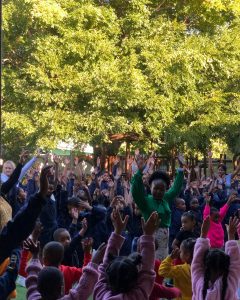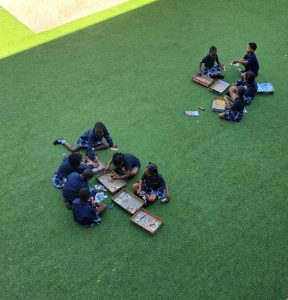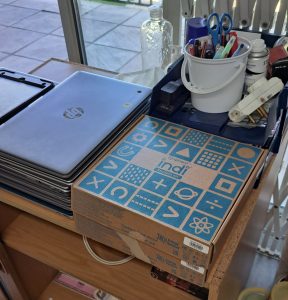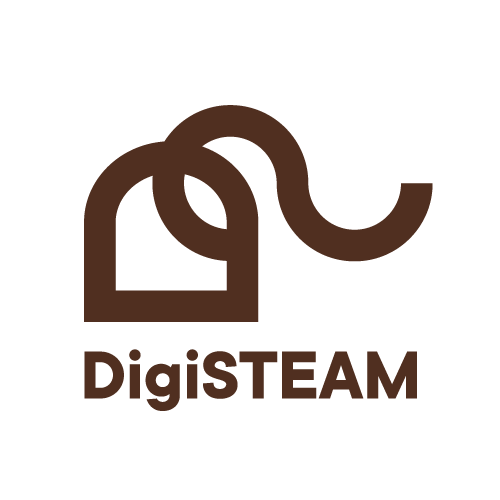Opiskelijat Ilari Itä-Suomen Yliopistosta, Noora Helsingin Yliopistosta ja Simon Stelleboschin Yliopistosta ovat kirjoittaneet tämän tekstin yhteistyössä |
Students Ilari from the University of Eastern Finland, Noora from the University of Helsinki and Simon from the Universivty of Stellebosch have written this text in collaboration
Molemmilla kouluvierailuilla yhdenvertaisuus näkyi siten, että jokainen oppilas pystyi osallistumaan omalla tasollaan opetukseen. Luovuutta oli nähtävillä niin opettajien opetustavoissa kuin oppimistehtävissä. Luovuutta ja yhdenvertaisuutta oli myös kielitietoinen opetus ja oppilaskeskeisyys. Pilkoimme havaintomme vielä STEAMin mukaisesti alaotsikoihin.
Science
Kouluvierailuissamme näimme oppimistehtäviä, joissa luovuutta käytettiin saavuttamaan haluttu lopputulos. Koululla oli käynnissä teemaviikko, joten oppimistehtävät yhdistettiin tähän aiheeseen. Ryhmätyö mahdollisti kaikki osallistumisen, yhdessä tekemisen ja keskustelun.
Technology
Koulussa teknologiaa käytettiin oppimisen välineenä kuten tiedonhakuun, mutta itse oppimistehtävää ei tehty sähköisesti. Laitteita käytettiin yhdessä, jolloin pädi oli väline yhteiseen vuorovaikutukseen. Luovuutta voi käyttää tiedonhaussa hakusanojen kautta tai miten tietoa löytää. Tietokone luokassa pelattiin erilaisia oppimispelejä ja opeteltiin esimerkiksi kieliä. Tämän on todella tärkeää Etelä-Afrikassa, jossa monet haasteet linkittyvät nimenomaan monikielisyyteen.
Engineering
Robotiikka oli osa opetusta. Insinööritaitoja käytettiin myös monialaisissa oppimistehtävissä. Yhteiset viikkoaiheet, jotka koko koulu jakaa lisäävät projektioppimisen ja ongelmanratkaisutaitoja. Yhdessä tekeminen ja onnistuminen ryhmässä lisää itseluottamusta ja mahdollistaa jokaisen oppilaan onnistumisen omalla tasollaan.
Art
Kaikilla tunneilla taide oli läsnä jollain tavalla. Asioita konkretisoitiin taiteen avulla. Taide ei tarvitse sujuvaa tai yhteistä kieltä. Tanssia kuvattiin sanoilla ”creative mind flowing” ja siksi se oli osa jokaista koulupäivää. Kouluvierailullamme viikon aiheena oli terveellinen ruoka, ja yksi luokka oli koonnut tästä upean STEAM-oppimiskokonaisuuden, jossa tehtävänä oli luoda ”superfood”: miettiä mitä se ravitsemuksellisesti sisältää ja luoda siihen pakkaus. Pakkaussuunnittelu oli piirtämällä, mutta mikään ei toki estäisi tekemistä kolmeulotteista pakkausta, jolloin myös käsityö olisi yhdistynyt tehtävään.
Mathematic
Oivallinen esimerkki konkreettisesta matematiikan oppimisesta näimme alkuopetuksessa, jossa opettaja opetti murtolukujen peruskäsitteitä hedelmien avulla. Näin lapset oppivat käsitteet ”puolikas” ja ”kokonainen” ilman, että itse murtoluku käsitettä esiteltiin. Teorian yhdistäminen todellisen maailman ilmiöihin ja ongelmiin, onkin yksi avainasioista oppimisessa samoin kuin perustaitojen ja peruskäsitteiden oppiminen. Selkeästi lapsilla oli hauskaa banaanitehtävän parissa.
Lopuksi
Näimme monipuolisesti, miten luovuus ja yhdenvertaisuus yhdistyy opetuksessa. Luovuutta näkyi sekä oppimistehtävissä, mutta myös siinä, miten olemassa olevia resursseja käytetään tarkoituksenmukaisesti. Oppilaat saivat koulussa edetä omalla tasollaan luokkakavereiden ja opettajan tuella. Koulu oli todella oppilasta varten, ei niin, että oppilas on koulua varten.


On both school visits, equity was visible in such a way that each student was able to participate in the teaching at their own level. Creativity was visible in both the teachers’ teaching methods and learning tasks. Language-aware teaching and student-centeredness also showed creativity and equality. We further divided our observations into subheadings according to the STEAM.
Science
On our school visits, we saw learning tasks where creativity was used to achieve the desired outcome. The school had a theme week on going, so the learning tasks were combined with this topic. Group work enabled everyone to participate, work together, and discuss.
Technology
In the school, technology was used as a learning tool, such as for information seeking, but the learning task itself was not done electronically. Devices were used together, making the tablet a tool for mutual interaction. Creativity can be used in information retrieval through keywords or how to find information. In the computer class, various learning games were played, and languages were learned, for example. This is really important in South Africa, where many challenges are specifically linked to multilingualism.
Engineering
Robotics was part of the teaching. Engineering skills were also used in multidisciplinary learning tasks. Common weekly topics that the whole school shares increase project learning and problem-solving skills. Working together and succeeding in a group increases self-confidence and enables each student to succeed at their own level.
Art
Art was present in some way in all lessons. Things were concretized through art. Art does not require fluency or common language. Dance was described with the words “creative mind flowing” and therefore it was part of every school day. On our school visit, the topic of the week was healthy food, and one class had put together a wonderful STEAM learning entity, where the task was to create a “superfood”: think about what it nutritionally contains and create a package for it. The packaging design was by drawing, but nothing would prevent making a three-dimensional package, in which case handicraft would also have been combined with the task.
Mathematics
An excellent example of concrete mathematics learning we saw in early education, where the teacher taught the basic concepts of fractions with the help of fruits. This way, the children learned the concepts of “half” and “whole” without introducing the fraction concept itself. Combining theory with real-world phenomena and problems is one of the key issues in learning as well as learning basic skills and basic concepts. Clearly, the children had fun with the banana task.
In conclusion
We saw a variety of ways in which creativity and equity combine in teaching. Creativity was visible both in learning tasks and in how existing resources are used appropriately. Students were able to progress at their own level in school with the support of classmates and the teacher. The school was really for the student, not so that the student is for the school.




Leave a Reply